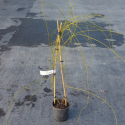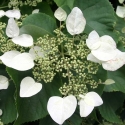Climbers and Vines - Just Arrived
CLICK HERE FOR MORE INFORMATION
Pruning a climber or vine in the early stages of its growth is important. As you nip out the growing tips, you encourage the plant to branch out, resulting in many stems that can be trained up the suport. As the climber matures, encourage prolific flowering by pruning, but be aware of the different flowering habits of different plants: some flower on old wood – last season’s growth, and some on new wood – the present season’s growth, so check before you prune. A very important element with regard to pruning is to ensure that you do not cut through a major stem as this will cause a whole section of the plant to die off.
Because a climber is likely to be a permanent fixture in the garden, it is wise to prepare the soil well before planting. Check that the soil is not filled with builder’s rubble as this is often the case next to walls. Include large quantities of organic compost and check that the drainage is good. You are only limited by your imagination. Some climbers such as Trachelospermum jasminoides (AKA Star Jasmine) and Ficus pumila can be used as either a ground cover or small climber depending on how you train the plant initially. Both of these climbers are evergreen. Of equal importance are deciduous climbers such as Clematis and Wisteria which flower in early spring and offer masses of delicate blooms as well as fragrance.
Have a browse through our range of climbers and we are sure you will find a plant that you can easily look up.
CLICK HERE TO CLOSE MORE INFORMATION

A native plant forming mounds of sprawling rush-like stems. Trained it can growing up as a climber. Very beautiful nodding cream flowers smoother the foliage in spring, followed by fluffy silver seed heads. Hardy to dry, open conditions. Evergreen
A great plant for grasslands, shrublands and rocky areas. Its natural range follows the dry eastern flanks of the lower North Island and South Island
Growing Clematis
Habit: Climbing
Leaves: Evergreen, Green
Mature Size (HxW): 3m x 1m
Clematis Afoliata
Expected Stock Height: 90/100 cm ?
Currently sold out. Add to your waitlist to be advised when next in stock.

aka Japanese Clg Hydrangea
A special climber from the Hydrangea family with broad oval leaves and small creamy flower heads in summer. These flowers are surrounded by drooping creamy-yellow bracts. Quite showy especially against a brick wall or similar where it will cling unsupported. Happiest in the sun, hardy and deciduous.
While Schizophragma (Ski-zo-frag-ma) prefers a sunny spot it can take some shade. The name means Schizo (to divide) and phragma (a wall).
Habit: Climbing
Leaves: Deciduous, Green
Mature Size (HxW): 6m
Schizophragma Hydrangoides
Currently sold out. Add to your waitlist to be advised when next in stock.
HL Nurseries Limited t/a Wairere Nursery
826 Gordonton Road, R D 1, Hamilton 3281 Ph: (07) 824 3430 Email: